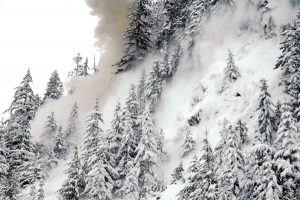
Keeping Snoqualmie Pass open in winter is serious work involving big explosions and a surplus U.S. Army tank.
Without avalanche control, snow slides can bury vehicles or close Interstate 90, which crosses the Cascade Mountains through the pass, for hours, said John Stimberis, the Snoqualmie Pass avalanche forecaster for the Washington State Department of Transportation.
To prevent that, Stimberis and other WSDOT employees set off explosives when the highway is closed. The blasts trigger precautionary avalanches, which greatly reduce the risk to motorists.
Snowfall this winter is on pace to match the five-year average overall, but a dry January preceded heavier snowfall in February and March. That, in turn, forced WSDOT to close I-90 for avalanche control several times during those months. In all, the state has had to close the highway for fewer than 50 hours for avalanche control so far this winter.
Most of the explosions Stimberis sets off are from charges placed on cable trams above potential avalanche paths. The slide areas are well documented by WSDOT staff.
The cable trams work for most potential paths, but for a few, Stimberis and his colleagues need another way to blast the built-up snow and ice loose.
For those hard-to-reach places, WSDOT has a gift from the military — an M60 battle tank.
The tank, leased from the Army, replaced WSDOT’s Korean War-vintage 105 mm recoilless rifle, another loaner from the military. The tank, which also has a 105 mm cannon, is quicker and easier to use than the recoilless rifle, which despite its name is certainly a substantial artillery piece.
M60 tanks, also known as M60 Patton tanks after America’s legendary World War II tank commander Gen. George Patton, served as the U.S. main battle tank from 1961 into the early 1980s. Militaries around the world still use the tank.
The ammunition is provided by the Army, which supplies 7-pound shells to about 20 highway avalanche control programs with tanks across the country, Stimberis said.
On the cable trams, WSDOT uses 28-pound explosives made from ammonium nitrate and diesel fuel.
The explosives offer a big punch with a stable mixture, Stimberis said.
He and his colleagues begin getting ready for avalanche season in October.
“Generally, we don’t see active avalanche control begin until Thanksgiving,” he said.
The season usually lasts until late March or early April.
This winter, the pass is on track to reach its average 435 inches of snowfall.
Each morning, Stimberis checks out a study plot to observe snow conditions and check meteorological instruments.
“We’re looking for certain weaknesses in the snow pack that may indicate elevated risk,” he said.
If there is an area of concern, he calls WSDOT’s maintenance section to clear traffic off I-90 in the pass. He and the rest of the avalanche control team go to the avalanche path they are concerned about.
Once they have the all clear from maintenance, they either lower explosives or fire shells at the risk area.
Usually it only takes one explosion to shake the loose snow and ice off the slope and trees, Stimberis said.
The maintenance crew waits a few minutes to let any secondary slide come down, and then they clear any snow from the roadway.
Depending on the amount of snow loosened by a blast, traffic can be stopped for as little as 15 minutes or as long as an hour.
Before working for WSDOT, Stimberis handled avalanche control for the Alpental ski area, which uses a smaller artillery piece to trigger precautionary slides.
When he was growing up, Stimberis said he never imagined a tank would be part of his job.
ON THE WEB www.wsdot.wa.gov/maintenance/avalanche
Filed Under Local News
